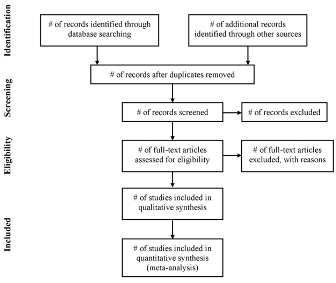Nursing Systematic Literature Review Writing Help
Systematic Literature Review Writing Services
A systematic literature review refers to a synthesis of primary research papers by employing a documented procedure in the search strategy and selection of studies. A systematic literature review focuses on providing a persuasive, comprehensive, and updated synthesis of studies in a specific area of scientific inquiry. The aim of the systematic literature review is to address a formulated question using an explicit method to identify publications, select publications related to the question, critically evaluate the publications, analyze the reported data from the relevant publication, and create a report of the combined results. Most nursing students writing a BSN, MSN, or DNP nursing capstone project are required to conduct systematic reviews. We assist such scholars by providing excellent writing services.
The two main methods used in undertaking a systematic literature review are the PICOS and randomized controlled trials (RCTs). PICOS defines the population, the intervention, the appropriate control, the outcomes of interest, and the study design. PICOS is useful to formulate research questions that would be agreeable to the literature review. RCTs method is used to collect evidence from primary studies to support the research question. In RCTs method, the evidence is ranked in relation to the hierarchy of evidence where meta-analyses and systematic reviews are considered superior in the hierarchy, while expert opinions occupy the lowest stage on the hierarchical ladder.
Steps to Follow When Writing a Nursing Systematic Literature Review
A collection of research is produced every year, often with contradictory findings. The differences between studies are caused by study alterations, flaws, or sampling variation. In a situation where there are conflicting findings, it is not possible to determine which results are reliable. The problem of conflicting findings makes it difficult for the researcher to decide which results to be used to form the basis for policy or practice decisions. By identifying, evaluating, and synthesizing findings of relevant primary studies to address specific research questions, systematic literature review helps in eliminating the problem of conflicting findings. The main steps that should be followed when writing a nursing systematic literature review include choosing a review topic, identifying relevant primary studies, synthesizing the literature, summarizing the evidence, and interpreting the findings.
1. Choosing a Review Topic
The first step in a systematic literature review involves identifying the topic. The researcher carrying out a quantitative study may have already decided on the topic, but an individual carrying out a non-research-based literature review choosing the topic is the first step. The task of choosing the topic is usually difficult due to the lack of adequate knowledge in the content area. However, one can choose a topic by identifying gaps from nursing practice setting or from suggestions for further research in journal articles. Additionally, an individual can consult an expert in the field of nursing to get help in choosing the topic.
2. Identifying Relevant Work
The second step in undertaking a systematic literature review in nursing is searching and choosing relevant articles. The search for appropriate studies should be extensive. The researcher should search multiple resources without language restrictions. The types of articles that should be selected for an accurate systematic literature review are theoretical presentations and empirical research papers. Reasons for exclusion and inclusion should be explained as one strives to eliminate articles that have flawed methods or that use wrong reasoning to support the findings.

3. Analyzing and Synthesizing Literature
After collecting the articles that one intends to use in the literature review, the next step is analyzing each of them. To analyze each of them, one needs to break them down to identify the important information. An individual would then synthesize and integrate the collected articles. The process of integration should involve identifying the conclusions drawn from the group of studies.
4. Summarizing the Evidence
The process of synthesizing data includes the tabulation of study characteristics, effects, and quality. An individual undertaking a systematic literature review in nursing can use statistical methods to explore differences between studies and merging their effects. One can also use the literature review matrix to compare and contrast articles with the aim of determining the scope of research within a given period. A review matrix helps a researcher to identify similarities and differences between journal articles in a specific research topic.
5. Interpreting the Findings
The issues highlighted in all steps should be met to ensure accurate findings are realized. During the process of interpreting the findings, the risk of publication bias and other biases should be explored. Exploration for heterogeneity is important to help in determining whether or not the summary can be trusted. Exploration for heterogeneity is also helpful in determining whether effects observed in selected studies can be used to generate inferences.
Considerations to Be Made When Writing a Systematic Literature Review
In nursing, systematic literature reviews are usually undertaken as a process of writing a research paper. A systematic literature review helps in setting the framework for a wider paper by exposing the individuals to the breadth of available information on a topic area. However, there are some factors that should be considered when writing a systematic literature review in nursing. The main factors to consider include the purpose of the literature review, available resources to access information, and ways of synthesizing collected information.
1. Purpose of the Literature Review
The person undertaking a systematic literature review must ascertain the purpose of the literature review. The researcher should be aware of the scope, purpose, and length of the literature review. When ascertaining the purpose of the literature review, one should specify the area of inquiry, and the amount of information required.
2. Available Sources of Information
Although a search for literature is easy due to information available electronically, one should identify available library resources. Libraries often provide personalized training on ways of accessing information. Additionally, librarians are usually available to offer help on specific topic areas.
3. Ways of Synthesizing Collected Information
After retrieving information from selected articles, one should embark on critical work of synthesizing it. A perfect systematic literature review involves a higher level of integrating collected information to produce a comprehensive analysis of the content. Writing of a systematic literature review should flow and integrate the findings of numerous sources to reinforce the importance of every subtopic area.
Summary
A systematic literature review involves providing a persuasive, comprehensible, and updated synthesis of primary studies in a specific area of scientific inquiry. By synthesizing primary research papers, a systematic literature review helps in eliminating the problem of conflicting findings. A systematic literature review eliminates the problem of conflicting findings by identifying, evaluating and synthesizing findings of relevant primary studies. The main steps to follow when writing the systematic literature review in nursing includes choosing a review topic, identifying relevant studies, analyzing available literature, summarizing the evidence, and interpreting the findings. The main factors to consider when undertaking a systematic literature review in nursing include the purpose of the literature review, available resources to get information, and the ways of integrating collected information. Following the right steps and taking all important factors into consideration would help in improving the quality of a systematic literature review. Feel welcome to have one of our experts write your nursing systematic literature review today. See our Order Process Page or join our live chat for more information.

|
|







